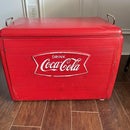Introduction: Foosball Table Upgrade
A tournament size foosball table, the kind you see in bars or arcades are 56" long X 30" wide X 36" high. These are usually sturdy and rugged enough to stand up to rough play without moving or travelling across the floor due to their heavy construction and weight. Unfortunately, they take up a lot of room and cost big bucks.
Most of us have the department store variety which are usually about 40" long X 24" wide X 33" high. Unfortunately, these suffer from weak construction, have a flexible playing surface and spindly legs. They are also feather light and tend to move when being played, especially by two adults or teenagers. They are also difficult to level.
This Instructable addresses how to upgrade a department store game so it has all the characteristics of a tournament style unit, even if it is 4/5 scale.
First, you need to acquire the game. I found one second- hand and paid $40 for it. I made sure it had a good playing surface (field) and that all 22 players were intact. Also, all rods were straight, moved properly and handles were attached.
Once you have the game and it meets those criteria, you can move to the next step.
Step 1: Strengthen and Improve the Board
Remove the legs, if it has them. Mine supported the sides as well so I cut them to the height of the board, Painted them black, and reinstalled them later as corner pieces using the original screws. I saved the levellers before I trashed the remaining parts of the legs. I turned the table over and soon realized that the playing surface sits in a groove and is not flat. It dips to the middle and is curved at the goal ends. It was supported by two stringers at 1/3 and 2/3 the length of the surface. They were merely held in place with screws. I removed them and cut two more using the same profile. I re- installed them, using the original screws but also glued them to the bottom of the playing surface with construction adhesive. I also glued the two new stringers in place at the underside at the goal ends and caulked the entire seam where the playing surface fits into its groove. Lastly, I cut a piece of 1/2"plywood to fit inside the frame and glued it to the stringers. All of this not only tightened up the game and removed any possibility that it would flex, it also added some mass, due to the plywood.
Turning the game back over, I cleaned up the field, tightened up all the players, (they are attached with screws that tend to loosen), and glued a piece of rubber 1/2" fuel hose to each corner. This will ad more challenge to the game and speed it up, not allowing the ball to go dead in a corner. I also had a 7" stencil of a soccer ball made and applied it to centre field, covering the logo of the off-shore manufacturer.
Since the non- handle end of most rods had their plastic protector pieces missing, I fashioned new ones from dollar store bouncy balls (5 for $1), simply drilling them and siliconing them to each rod. I had the safety of young players in mind with this feature.
Since the frame is only made of 1/2" MDF, the top edge of which was finished with a glued on strip of plastic, I made a top moulding of 1,1/2" X 1/2" primed MDF and painted it gloss white. Glued to the top edges, it resembles end and side lines but really adds a lot of strength.
Step 2: Make the Base
Before constructing the base, I added one more moulding to the bottom edge of the board for no other reason that it covered a cheap looking stripe decal. It also makes the game look more substantial.
The base had to support the game and be heavy enough that it wouldn't move during rough play. It also had to have adjusters to level it. I used construction 4 X 4's as legs and 1/2' plywood as a skirt. The legs were sized so the top edge of the game sits 34" from the floor. The parts were simply glued and screwed together. I drilled the bottom of each leg to accept the hammer- in adjusters that I saved from the original legs. The base was sized to fit snugly inside the frame of the game. The new plywood bottom of the game sits on the ridge of the skirt and on top of the 4 X 4's. I added a ledge so screws can be driven into the plywood bottom so the game is permanently attached to the base.
The base was sanded, primed and painted. For good measure, I added a white stripe as well.
For less than $100, including the original game. I now have a sturdy, attractive, 4/5 scale foosball game that once levelled, will stay that way and stand up to hours of rough play.













